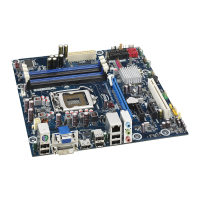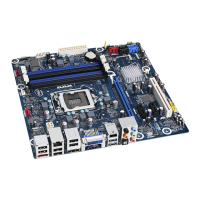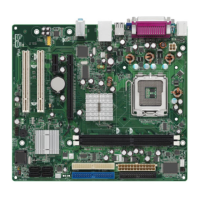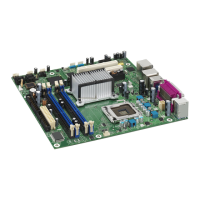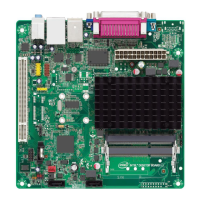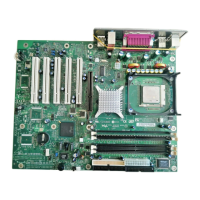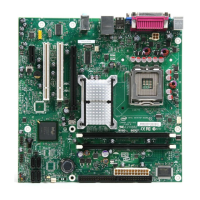22 Intel
®
440Bx Scalable Performance Board Development Kit Manual
Theory of Operation
3.2.2.2 Accelerated Graphics Port (AGP) Interface
The 82443BX supports an AGP interface. The AGP interface has a maximum theoretical transfer
rate of ~532 Mbytes/s.
3.2.2.3 System Clocking
The 82443BX operates the system bus interface at 66 or 100 MHz, the PCI bus at 33 MHz and the
AGP at a transfer rate of 66/133 MHz. The 82443BX clocking scheme uses an external clock
synthesizer that produces reference clocks for the system bus and PCI interfaces. The 82443BX
generates the AGP and DRAM clock signals. Please refer to the CK97 Clock Synthesizer/Driver
Design Guidelines (order number 243867).
3.2.3 In-Target Probe
The evaluation board is populated with a 2.5 V or 1.5 V In-Target Probe (ITP) debugger port. The
ITP port provides a path for debugger tools like emulators, in-target probes, and logic analyzers to
gain access to the processor registers and signals without affecting high speed operation. This
allows the system to operate at full speed with the debugger attached.
Caution: When using a 300A, 366 or 433 MHz Celeron processor, you need to use a 2.5 V ITP plug. When
using a 566 MHz or faster Celeron processor, or a Pentium
III processor, you need to use a 1.5 V
ITP plug. Using the wrong ITP voltage can damage the processor.
3.2.4 82371EB PCI to ISA/IDE Xcelerator (PIIX4E)
The 82443BX is designed to support the PIIX4E I/O bridge. The PIIX4E is a highly-integrated
multifunctional component that supports the following:
• PCI Revision 2.1 compliant PCI-to-ISA bridge with support for 33-MHz PCI operations
• ACPI Power Management support
• Enhanced DMA controller, interrupt controller and timer functions
• Integrated IDE controller with Ultra DMA/33 support
• USB host interface with support for two USB ports
• System Management Bus (SMB) with support for DIMM Serial Presence Detect
3.2.5 DRAM
The evaluation board provides two 168-pin DIMM module connectors. The DRAM interface is a
64-bit data path that supports Synchronous DRAM (SDRAM). The DRAM interface supports
4 Mbytes to 256 Mbytes of 4-Mbit, 16-Mbit and 64-Mbit DRAM and SRAM technology (both
symmetrical and asymmetrical). Parity is not supported. One 100 MHz, 32-Mbyte SDRAM DIMM
is included in the kit.

